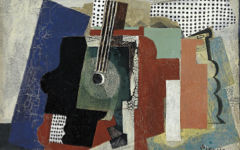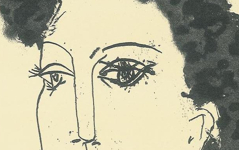Picasso’s Head of Picador with Broken Nose (1903)
Picasso was 22 when he first tried his hand at sculpture, modeling clay in a Barcelona studio. The most important of his very first pieces is Head of a Picador with a Broken Nose (left) which has rightly been connected with the first major work of the young Rodin.1
Click next thumbnail to continue
Rodin was also 22 when he sculpted Mask of the Man with a Broken Nose (left), intending to submit it to the 1863 Salon. Several people have testified how Rodin asked a man from the neighborhood to pose for him, a weather-beaten man with an "ugly" face and broken nose. Yet Rodin, like Manet, chose his models carefully so that their features and sometimes even their biography match the artist's intention.2
Click next thumbnail to continue

Daniele da Volterra, Bust of Michelangelo, said to be after his death-mask (1564)
Click image to enlarge.
In this case Rodin chose a model with a broken nose because Michelangelo had one (left), famously cracked in a fight with another artist. Given that Michelangelo was the greatest sculptor of all time and Rodin, still alive, perhaps the greatest French sculptor, they were the men whose works and reputation the young Picasso aimed to surpass, in part by internalizing their own persona into his work. He once even claimed that the great artists were reincarnations of one another, the same ‘Little Man’, he called him, from prehistoric times through Velázquez, Rubens, Rembrandt and others to himself, though he added: "Maybe it’s me – how do we know?"3
Click next thumbnail to continue

Michelangelo, Detail of an angel in The Madonna and Child with St John and Angels known asThe Manchester Madonna (c.1497)
Click image to enlarge.
As for the importance of Michelangelo's nose, it does not seem to have been noticed by other experts that several of Michelangelo's figures, including an angel in The Manchester Madonna in London (left), have a broken nose to identify them as an alter ego or internal spirit of the master. It became a kind of personal emblem for Michelangelo. Both Rodin and Picasso, familiar with the language of artists, are likely to have recognized that.
Click next thumbnail to continue
In modeling Head of a Picador with a Broken Nose the young Picasso felt at one with the young Rodin of the same age who, in turn, identified with the young Michelangelo. All three of them might even have imagined the process of having one's nose broken as a sculptural metaphor. The blow, after all, reshapes the facial features like a sculptor modeling clay. Thus, on the artist's own face or that of an alter ego the flattened nose suggests that the sculptor sculpted himself. In this manner Picasso made his first important sculpture into a statement of his early ambition to rival the achievements of his great predecessors while prolonging their tradition.
See conclusion below
It is widely known that Picasso identified with the motif of a bull and that where a bull appears so does Picasso. It is less well-known that he also identified with the bull's opponents, the matador and the picador as Manet had before him. Picasso's choice of the term picador for the title of this early work initially seems curious. Why choose the lowly picador, on his horse with a lance? He might just as easily have called it a Toreador or even a Matador or an Espada as Manet had titled Mlle. V. Yet he chose the name picador, I believe, not only because the man is perhaps too beaten to resemble the proverbial good looks of a matador but because the first four letters of his profession match those of his own name, Picasso. So keep an artist's name in mind when you try to interpret art because when part of it appears, as here, in an unlikely place it always confirms the presence of an alter ego. The head of the picador, it now appears, is the 22-year old Picasso as the 22-year old Rodin as the young Michelangelo, a trinity of great sculptors all destined for immortality, the two masks suggesting that art is a performance of both hidden and changing identity.
More Works by Michelangelo, Picasso
Genres are an artificial classification of little meaning. For instance, as here, still-life without life would be still-born.

Picasso’s Still-Life with Door, Guitar and Bottles (1916)
Notes:
1. Werner Spies, Picasso: The Sculptures (Hatje Cantz) 2000, p. 24
2. Manet, for example, chose an actor who was also a part-time painter as his model for The Tragic Actor which I have shown depicts a hidden "painter." The actor's double life as an actor and painter is therefore true on both levels, life and art.
3. André Malraux, Picasso’s Mask, trans. J. and J. Guicharnaud (Holt, Rinehart and Winston) 1976, pp. 126-7, 141-3
Original Publication Date on EPPH: 06 Apr 2011. | Updated: 0. © Simon Abrahams. Articles on this site are the copyright of Simon Abrahams. To use copyrighted material in print or other media for purposes beyond 'fair use', you must obtain permission from the copyright owner. Websites may link to this page without permission (please do) but may not reproduce the material on their own site without crediting Simon Abrahams and EPPH.





